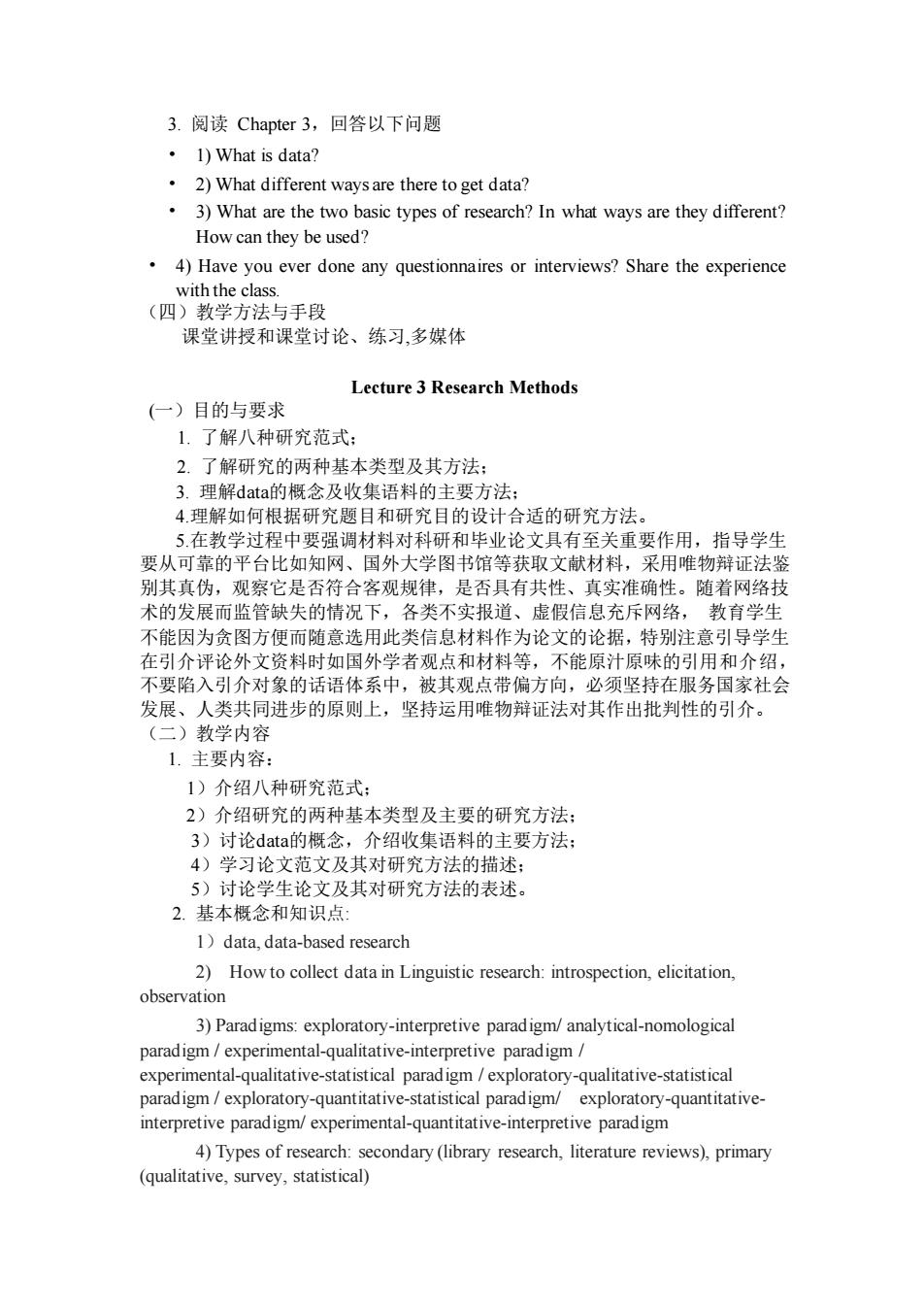正在加载图片...

3.阅读Chapter3,回答以下问题 ·l)What is data? .2)What different waysare there to get data? 3)What are the two basic types of research?In what ways are they different? How can they be used? 4)Have you ever done any questionnaires or interviews?Share the experience with the class (四)教学方法与手段 课堂讲授和课堂讨论、练习,多媒体 Lecture 3 Research Methods (一)目的与要求 1.了解八种研究范式: 2.了解研究的两种基本类型及其方法: 3.理解data的概念及收集语料的主要方法 4理解如何根据研究题目和研究目的设计 合活的研究方法 5.在教学过程 要 调材 具有 重要作用,指导学生 要从可靠的平台比如知网、国外大 图书馆等获取文献材料 采用唯物辩证法鉴 别其真伪,观察它是否符合客观规律,是否具有共性、真实准确性。随着网络技 术的发展而监管缺失的情况下,各类不实报道、虚假信息充斥网络,教育学生 不能因为贪图方便而随意选用此类信息材料作为论文的论据,特别注意引导学生 在引介 评论外文资料时如国外学者观点和材料等 不能原 汁原味的引用和介绍 不要陷 个对象的话语付 系中 观点带偏方向,必须坚持在服务国 家社会 发展、人类共同进步的原则上,坚持运用唯物辩证法对其作出批判性的引介。 (一)教学内容 1主要内容: 1)介绍八种研究范式: 2)介绍研究的两种基本类型及主要的研究方法 3)讨论data的概念 介绍收集语料的主要方法: 4)学习论文范文及其对研究方法的描述: 5)讨论学生论文及其对研究方法的表述。 2基本概念和知识点: 1)data,data-based research 2)Howto collect datain Linguistic research:introspection,elicitation. observation 3)Paradigms:exploratory-interpretive paradigm/analytical-nomological paradigm/experimental-qualitative-interpretive paradigm/ experimental-qualitative-statistical paradigm/exploratory-qualitative-statistical paradigm/exploratory-quantitative-statistical paradigm/exploratory-quantitative- interpretive paradigm/experimental-quantitative-interpretive paradigm 4)Types of research:secondary(library research,literature reviews),primary (qualitative,survey,statistical) 3. 阅读 Chapter 3,回答以下问题 • 1) What is data? • 2) What different ways are there to get data? • 3) What are the two basic types of research? In what ways are they different? How can they be used? • 4) Have you ever done any questionnaires or interviews? Share the experience with the class. (四)教学方法与手段 课堂讲授和课堂讨论、练习,多媒体 Lecture 3 Research Methods (一)目的与要求 1. 了解八种研究范式; 2. 了解研究的两种基本类型及其方法; 3. 理解data的概念及收集语料的主要方法; 4.理解如何根据研究题目和研究目的设计合适的研究方法。 5.在教学过程中要强调材料对科研和毕业论文具有至关重要作用,指导学生 要从可靠的平台比如知网、国外大学图书馆等获取文献材料,采用唯物辩证法鉴 别其真伪,观察它是否符合客观规律,是否具有共性、真实准确性。随着网络技 术的发展而监管缺失的情况下,各类不实报道、虚假信息充斥网络, 教育学生 不能因为贪图方便而随意选用此类信息材料作为论文的论据,特别注意引导学生 在引介评论外文资料时如国外学者观点和材料等,不能原汁原味的引用和介绍, 不要陷入引介对象的话语体系中,被其观点带偏方向,必须坚持在服务国家社会 发展、人类共同进步的原则上,坚持运用唯物辩证法对其作出批判性的引介。 (二)教学内容 1. 主要内容: 1)介绍八种研究范式; 2)介绍研究的两种基本类型及主要的研究方法; 3)讨论data的概念,介绍收集语料的主要方法; 4)学习论文范文及其对研究方法的描述; 5)讨论学生论文及其对研究方法的表述。 2. 基本概念和知识点: 1)data, data-based research 2) How to collect data in Linguistic research: introspection, elicitation, observation 3) Paradigms: exploratory-interpretive paradigm/ analytical-nomological paradigm / experimental-qualitative-interpretive paradigm / experimental-qualitative-statistical paradigm / exploratory-qualitative-statistical paradigm / exploratory-quantitative-statistical paradigm/ exploratory-quantitativeinterpretive paradigm/ experimental-quantitative-interpretive paradigm 4) Types of research: secondary (library research, literature reviews), primary (qualitative, survey, statistical)